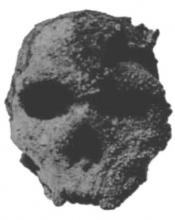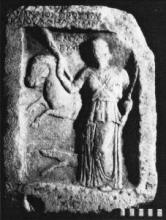By Constantinos Nt... on March 02, 2018
Strophalos or Iynx is an ancient hellenic symbol dated before 2300 b.C. It was connected with the Goddess Hekate and later with Her aspect of Cosmic Soul, sending the Ideas from the Paternal God to the Creator God. Strophalos, triskelion, gammadion-tetraskelion and labyrinth are symbols that look like each other but the uses of strophalos are quite different. Through the help that was provided by the ancient Hellenes writers from Xenophon to Proclus, Damascius and Michael Psellos we will discover the uses, the form and the idea behind the magickal tool of the Witches-Theurgists of Hekate.
By Constantinos Nt... on March 02, 2018
In this article you will read how the ancient Atheneans used to bury their dead, how they saw death from 3000 b.C.until the Roman period 300 a.C. The place we will use as a focal point is the Kerameikos, a part of Athens which was really important for daily life in ancient periods. Kerameikos is a crossroads between sacred way of Eleusis, a sacred way to Demosion Sema, the graves of all highli respected warriors and Atheneans and a road to ancient agora. Atheneans used to bury their dead in Kerameikos. The had sacred places for main Gods and Goddesses, special buildings from woman of Aphrodite, laboratories and market full of merchants of wine, food, pottery and artists.
By Constantinos Nt... on March 02, 2018
Dipylo, Pompeio, Z, and the heated Valaneio. The buildings of the east side of Hiera Odos.
By Eirini Tsotsou on March 02, 2018
In this article you are going to read ancient texts from the book of Pausanias the geographer, which are related to Hekate. In this article we are meeting our Goddess in Corinth, Argolis and Aegina.
By Constantinos Nt... on March 01, 2018
In the ancient city of Hyampolis from the copper era (2000 b.C.) the Goddess Artemis and the God Apollo were worshipped until the Byzantine period of 4th century a.C. For many centuries in that area, Artemis was the main Goddess (at least from 13th century b.C.). From this area, the cult of Apollo expanded and went to Athens. The modern name of Hyampolis is Kalapodio. In 1973 German archaeologists under Rainer Felsch discovered the temple of Elaphivolos Artemis. The epithet means deer hunter. The temple is similar to Parthenon of Athens. Some people also believe that the same artist, Iktinos was the designer.
By Constantinos Nt... on March 01, 2018
In this -not Hekate related- article, I am going to present some clues of the lifework of the Hellenic top scientist Aris Poulianos. He is the founder of the Anthropological Association of Greece. The following evidence have been presented in the hellenic magazine ΔΑΥΛΟΣ in February 1996, issue170
By Constantinos Nt... on March 01, 2018
One night before the Dark Moon, in ancient Hellas, food was offered to the Goddess Hekate by all citizens, in public places. Deipna (or suppers in english) were left in theee ways crossroads (triodos), a sacred place for Hekate. The offerings has two meanings, to calm the Goddess in their favor and to protect her followers. Moreover, spirits and ghosts who were wandering this night could find pleasure. The result of this action was that those spirits would not cause troubles in the city.
By Constantinos Nt... on March 01, 2018
According to the arcaeological evidence Eleusis was inhabited at 1900 b.C. Houses have been found at the southwest area of Thriassio Pedio. At 1850 b.C. many houses are built and the kingdom of Keleos is starting to arise. His kingdom expanded to Kithairon, Parnetha and Aigaleo. Eleusis was a crossroads between Athens, Pelopponese and Thebes. Due to her position, the Atheneans wanted to incorporate Eleusis to their demos (municipality).
By Constantinos Nt... on March 01, 2018
Eleusinia
The oldest celebration in Eleusis. Some people think that Eleusina and Mysteries of eleusis are the same celebration. Eleusinia were the oldest and biggest celebration of Hellas. Aristotle writes that Eleusinia were a big event before all the other events of his time. When Eleusinia started they were organized every five years. Then, three more years added and they were called Big Eleusinia. Sport games, musical competitions, horse races were a part of the celebration in order to honor and thank the Goddess for the food she gave to people through the land.
Sports was a main way to honor a Goddess in ancient times. So athletes were honoured. The winners earned ear from Rhario Pedio,the first place that Triptolemos had cultivated.
By Constantinos Nt... on March 01, 2018
History
The first Orphic Hymn is dedicated to the Goddess Hekate and it starts with the epithet Enodia. In hellenic Ἐννοδία or Ἐνοδία, means of the roads. Let’s explore it’s history! As you will notice, Hekate and Enodia have many things in common.
Pages



















It amazes me how so many traditions follow these ancient protocols and roles,